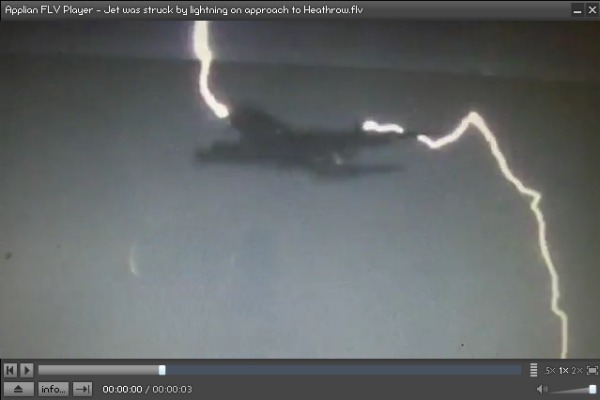Video: How Passenger Jet Survived Direct Lightning Strike

When an Airbus 380 from Dubai came in for landing at Heathrow Airport on a recent stormy night in London, it was struck by a giant bolt of lightning. The event was caught on camera, giving the world a rare glimpse of what's actually a common occurrence.
The average commercial airliner gets struck by lightning a little more than once a year. By analyzing the few videos that exist of such incidents it's not often that people happen to record airplanes right at the moment they are struck atmospheric scientists have figured out how and why it happens.
According to Vlad Mazur, a leading lightning expert with the National Atmospheric and Oceanic Administration (NOAA), the majority of lightning strikes to planes are actually triggered by the planes themselves. The metal bodies of the planes intensify the electric field of storm clouds as the aircraft pass through them; this can sometimes lead to an electrical breakdown.
Artificial trigger
"In the video, this is without a doubt a triggered flash," Mazur told Life's Little Mysteries. "You can see it's a dark sky, so you have rain and other evidence of a recent thunderstorm. Natural lightning had most likely ended already, but in decaying storms you have a very high electric field. It's enough to support the development of lightning , but there is no natural mechanism for initiating lightning discharge. When an airplane comes in, it acts as an artificial trigger."
The metallic (mostly aluminum) body of the plane acts as a conductor, he said. Amid the electric field of the storm cloud, positive charge builds up on one side of the conductor and negative charge on the other side. "The charge accumulates at places where the curvature [of the plane] is very sharp, like the nose and the tips of the tail and wings," Mazur explained. "These charged extremities intensify the ambient electric field. Then you have a leader (a spark), which initiates the development of a plasma channel." Voila: lightning.
{youtube 7J1nFadQt5Y}
Sign up for the Live Science daily newsletter now
Get the world’s most fascinating discoveries delivered straight to your inbox.
According to Bill Rison, an electrical engineer and lightning physicist at New Mexico Tech, two plasma channels, which are the paths electric charge moves along during a lightning strike, can clearly be seen in the video traveling out from opposite points on the airplane.
"A negative leader leaves one tip and a positive leader leaves a different tip, usually at opposing ends of the plane. In the [video] you can see two channels, one from the nose of the plane going upward, and the other from the tail of the plane going downward. I expect that the upward leader from the nose is positive (going up into the negative charge in the cloud), and the downward leader from the tail is negative," Rison said.
Most often, planes weather lightning just fine. Electricity passes around it, not through. Of the 140,000 aviation accidents on record in the National Transportation Safety Board (NTSB) database, only 24 were lightning-related. Most of those involved small private planes or helicopters, and only five incidents involved fatalities. By far the worst plane crash ever caused by lightning happened in 1963,when a strike ignited the fuel tank of a plane over Elkton, Md. Though passengers were shielded from the electricity in the strike, the fuel tank explosion forced the plane to crash, killing all 81 passengers and crew members.
Smooth curves
State-of-the-art engineering like that of the Airbus 380 prevents such disasters today. How do the planes handle a 30-million volt bolt of electricity?
The fuselage of the plane shown in the video, like that of most planes, is made mostly of aluminum. When lightning strikes the wingtip, nose or tail of a plane, electricity courses over its smooth aluminum shell without building up on any edges or penetrating inside. "In this case it sweeps above the top of the fuselage," Mazur said.
Furthermore, fuel tanks are tested to ensure they can withstand a lightning strike without producing dangerous sparks, and all on-board electronics and navigation equipment are grounded and protected from electrical surges. [How Are Plane Electronics Grounded? ]
However, all that engineering doesn't mean pilots are nonchalant about flying into thunderstorms: NTSB reports are littered with accidents caused by severe turbulence , icy conditions and nasty crosswinds. The lightning strike didn't endanger passengers in this Airbus, but they're lucky to have landed safely, nonetheless.
Follow Natalie Wolchover on Twitter @nattyover.
Natalie Wolchover was a staff writer for Live Science from 2010 to 2012 and is currently a senior physics writer and editor for Quanta Magazine. She holds a bachelor's degree in physics from Tufts University and has studied physics at the University of California, Berkeley. Along with the staff of Quanta, Wolchover won the 2022 Pulitzer Prize for explanatory writing for her work on the building of the James Webb Space Telescope. Her work has also appeared in the The Best American Science and Nature Writing and The Best Writing on Mathematics, Nature, The New Yorker and Popular Science. She was the 2016 winner of the Evert Clark/Seth Payne Award, an annual prize for young science journalists, as well as the winner of the 2017 Science Communication Award for the American Institute of Physics.











